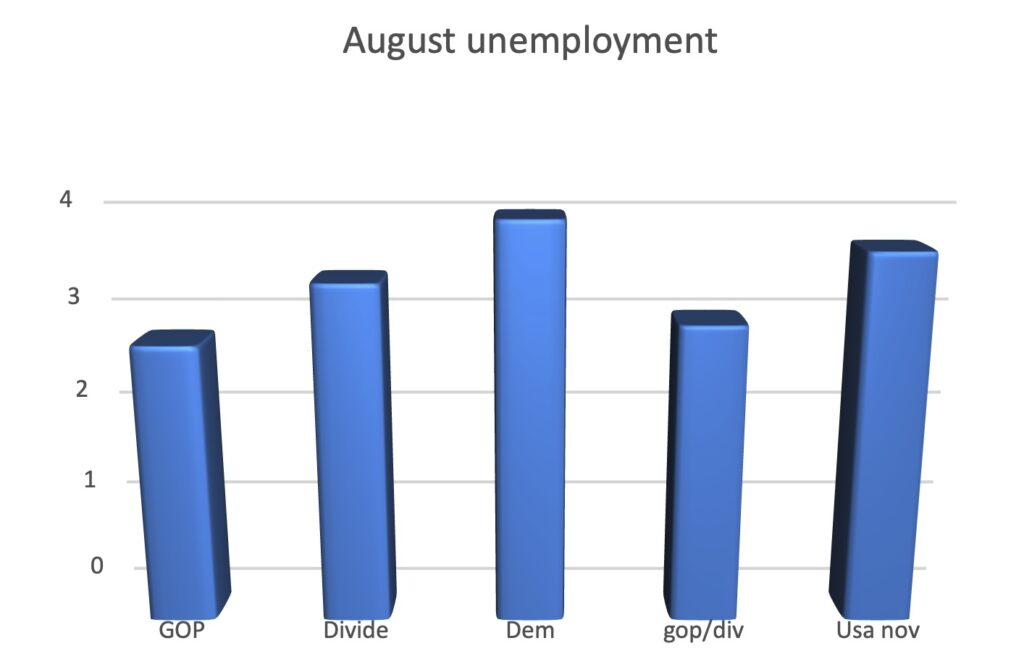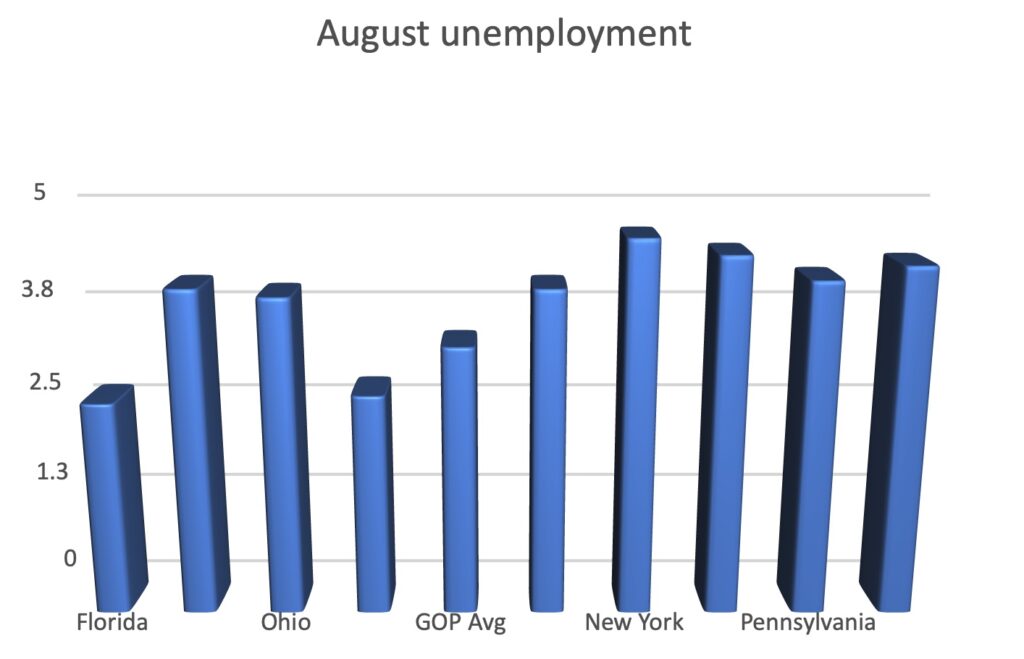By Tom Donelson, Senior Fellow
Since August 2020 and during the pandemics, there has been one constant: unemployment in Republican states have been significantly lower than in Democratic states. The chart below shows this

In August of 2020 unemployment for states with Democratic governors was 8.4 compared to 6.4 unemployment for Republican governors and in August 2022, unemployment under Democratic governors was 3.7 percent and under Republican governors was only 3 percent.
We also compared states with exclusively one-party control of the both the legislature and the executive with branch mixed control with one party who split control of the lever of power and found differences. Republicans who control both the legislature and governor seats, had an unemployment rate of 2.8 percent compared to Democrat states who control both the governor seat. and the legislature had an unemployment rate of 4 percent. Those who had mixed government had an unemployment rate of 3.4.
Completely run blue states had 30 percent more unemployment than completely run red states and these Democrats run states were even behind those states with split control. We did not find a difference between states with Republican governors and split government and Democratic governors with split government as GOP governors was 3.4 percent and Democratic governors was 3.3 percent. When we combined GOP governors and split governance, we see the unemployment is 3 percent.

We also compared the top four most populous states with Republican governors: Florida, Ohio, Texas, and Georgia to top four populous states with Democratic governors: New York, California, Pennsylvania, and Illinois. States with Republican governors had unemployment of 3.4 percent and two, Florida and Georgia, were below the national average and below 3 percent. The Democratic states averaged 4.4 percent and not one of these states were below the national average. Not one Democratic state had unemployment less than 4.1 percent.

The main reason for this difference is that Republican states open their economy earlier during the Pandemics compared to Democratic states. While some GOP states were aggressive with lockdowns initially, GOP states reduce restrictions, and this showed up in the lower unemployment.
Dr. Wilfred Reilly conducted three studies on the impact on the lockdown and found that there were no real differences in deaths per capita and both non-lockdown states and Republican states had lower unemployment compared to lockdown states and Democratic states. 1 Unemployment for non-lockdown states was 5.5 percent and for Republican states 6.4 percent whereas lockdown states and Democrat states unemployment was 8.2 percent in August of 2020.
In winter of 2020, many states reinstate lockdowns and in reviewing those states in August 2022, the unemployment was 3.5 percent for lockdown states compared to 2.8 percent for non-lockdown states. In both studies, all the non-lockdown states had Republican governors and in those states in which Democrats ran all phrase of government, the unemployment rate was 4 percent.
What we find for the past two years is that Republican states have lower unemployment compared to their Democratic counterpart and we found this difference most significant. Other studies support this including a report card by Casey Mulligan, Phil Kerpen and Steve Moore. They observed, “Economy and schooling are positively correlated (correlation coefficient = 0.43), which suggests a relationship between the willingness of the population (or its politicians) to resume normal activity in business and school. MT, SD, NE, and UT are the states’ highest on the economy score and among only seven states to exceed 85 percent open schools. The correlation between health and economy scores is essentially zero, which suggests that states that withdrew the most from economic activity did not significantly improve health by doing so.”2
- Ignored cost: Effect Yes-No lockdown states along with Red-Blue states political partisanship and other variables on April-August unemployment across the United States. Sept 2020
- A FINAL REPORT CARD ON THE STATES’ RESPONSE TO COVID-19 by Casey Mulligan, Phil Kerpen and Steve Moore April 2022